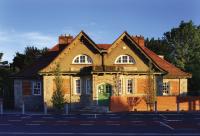Whitechurch Carnegie Free Library
Published in 20th Century Social Perspectives, 20th-century / Contemporary History, Features, Issue 5 (Sept/Oct 2012), Volume 20
Whitechurch Carnegie Free Library
The Whitechurch Carnegie Free Library first opened its doors on St Patrick’s Day 1911. It was designed by Thomas Joseph Byrne (1876–1939), then council clerk and architect to the South Dublin Rural District Council. Byrne was born in Kingston-on-Thames and commenced his study of architecture at the age of fifteen, articled to Edward Carter ARIBA (d. 1949) of London. Before graduating, he spent some time in Ireland in the office of Anthony Scott (c. 1844–1919) in Drogheda, working mainly on the many housing schemes carried out by Scott’s practice. After completing his architectural studies with the Royal Institute of British Architects in 1899, he worked with London County Council before returning to Ireland in 1901 to work for the South Dublin Rural District Council. As council clerk he was at the centre of things, and it must have been a steep learning curve for a relatively inexperienced young Englishman to get to know the job thoroughly and to establish himself with the staff and elected members of the council. It is no surprise, therefore, that his early architectural output was unremarkable. His potential must have been clear to some, however, for in 1909, at the age of 33, he was commissioned to design the new Carnegie Free Libraries in Clondalkin and Whitechurch in south County Dublin.Byrne seems to have designed the Whitechurch building during the short few months between the granting of £1,250 by the Carnegie Trust in September 1909 and his submission of drawings for approval in December. The plan form is similar to that of two earlier south county libraries, Glencullen and Sandyford, which were designed by Rudolph Maximilian Butler (1872–1943) and opened in 1907. Whitechurch is much larger, however, and clearly displays Byrne’s preference for the Arts and Crafts style, which had influenced his submission for his RIBA final exams a decade earlier. His use in Whitechurch of quality materials, locally sourced in so far as was possible, the tiled pitched roofs with generous overhangs, and the roof trusses exposed internally over a well-proportioned open-plan space divided only by glazed folding partitions are all marks of the Arts and Crafts influence.He also incorporated elements such as fireplaces with simply detailed marble surrounds and Diocletian windows, also found in Clondalkin Library; this may perhaps show the influence of the English architects who were in the forefront of progressive architecture when he was a student, such as Richard Norman Shaw RA (1831–1912). At Whitechurch Byrne got the opportunity not only to display his considerable talent in the overall building design but also to design the fittings and furniture that were to be used in the building. Unfortunately, most of those original chairs, bookcases, shelving units and tables did not survive the ‘improvement’ works carried out over the last two decades.The ideas of the Arts and Crafts movement continued to be an important part of Byrne’s work. Around the same time, he was able to influence his colleagues on the council to embark on a major building programme of rural labourers’ cottages that were a considerable improvement, in terms of construction and space, on what had gone before. His excellent cottages and houses on Whitechurch Road, using a combination of local granite, yellow brick and slated roofs, and incorporating modest but fine detailing, are still much sought-after today. HI
Michael Fewer is an architect and writer. Series based on the National Inventory of Architectural Heritage’s ‘building of the month’, www.buildingsofireland.ie.
















